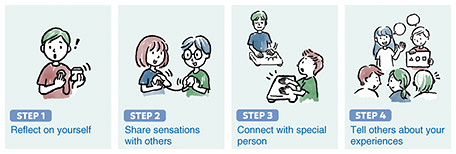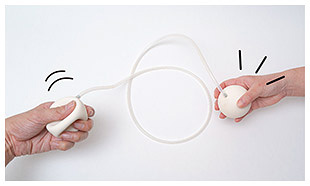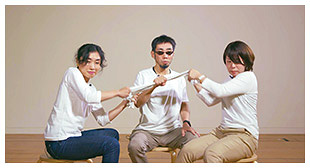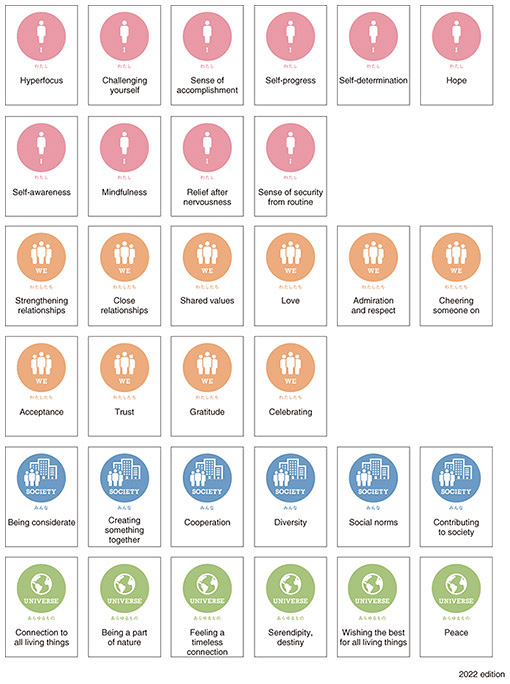 |
|||||||||||||||||||
|
|
|||||||||||||||||||
|
Front-line Researchers Vol. 20, No. 11, pp. 6–11, Nov. 2022. https://doi.org/10.53829/ntr202211fr1 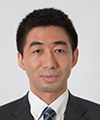 Researchers Are Like Mirrors that Reflect the FutureAbstractTo develop information and communication technologies that enable heart-to-heart communication, researchers at Human Information Science Laboratory in NTT Communication Science Laboratories study the information-processing mechanisms underlying human perception and emotion on the basis of information science, psychology, and neuroscience. We interviewed Junji Watanabe, a senior distinguished researcher investigating the mechanism of tactile sensation and its application to transmission technology as well as supporting the improvement of well-being, about the progress of his research. Keywords: haptics, well-being, Self-as-We Pursuing methodologies to ensure the well-being of diverse people—It has been three years since our last interview. Could you tell us about your current research activities? My research focuses on haptic communication and its value to society. The sense of touch allows us to feel our state of being as well as contributes to building empathy and trust between people. In conjunction with my research on haptic communication, I’m investigating methodologies to improve well-being. From 2020 to 2021, we held a series of workshops using haptic-communication tools with about 30 elementary-school students (11–12 years old) in Yokohama City [1]. This “Touch and Connect Sports Lab” was attended by members of NTT laboratories and the para-athlete Akihito Tanaka, a member of a special-purpose subsidiary of NTT called NTT Claruty, to create a hands-on learning environment toward an inclusive society. Since the workshops were held during the COVID-19 pandemic, we struggled to find a way to provide a genuine learning experience for the students while also taking measures to prevent the spread of infection. This workshop consisted of four sessions called the “Four Steps of Sensory Experience” (Fig. 1). In Step 1 “Reflect on yourself,” the students participated in a workshop called “Heartbeat Picnic” in which they could feel their own heartbeat through the sense of touch using their hand. When the students placed the stethoscope over their chest, the square box they were holding vibrated in sync with their heartbeat. Thus, they could feel their beating heart as a tactile sensation with their hand.
In Step 2 “Share sensations with others,” the sensory experience was shared with surrounding people. As an extension of the work in Step 1, the box that vibrates to the heartbeat of the student was passed to another student so that the other student could feel the heartbeat of the former student on their hand and vice versa. By feeling the heartbeats of others, each student became keenly aware that the other students were alive in the same way as he or she was alive. The students also used an air-transmit haptic communication device (Fig. 2) to experience communicating emotions through tactile sensation alone. This device consists of two soft balls connected by a tube, and one of the balls (held by one student in one hand) inflates when the other (held by another student in one hand) is squeezed. The vivid experience of the ball swelling in one’s response to the other person’s feelings is an experience of connecting with that person that is not possible with words [2].
In Step 3 “Connect with special person,” students experienced communicating with people having different senses and bodies that they would not usually come into contact with. During this step, para-athlete Akihito Tanaka joined in the workshop, and we used a tactile sharing table that vibrated when a student tapped in a manner that enabled the student to react to Akihito’s story. In Step 4 “Tell others about your experiences,” students told lower-year students about their sensations they had experienced and the lessons they learned about inclusive societies. I believe that through this workshop, students can discover their own senses, connect with others, meet other people having different senses and bodies, and learn with a sense of reality how we can live together in society. I believe that this is a fundamental experience for creating a society in which people live with respect of one another and ensure their well-being. —Discovering one’s senses sounds exciting. Could you tell us about another study? I’ll introduce a project called “Sports Social View” [3], which uses tactile sensation to enable normal-sighted people and the visually impaired to share the excitement of sports watching. The visually impaired typically attend sports events while listening to audio commentary. However, there are two problems with audio commentary. It is unable to effectively express the details of sports movements in words, and the visually impaired are left out of the excitement of spectators surrounding them. Considering these problems, we developed a method of spectating sports by which the action happening in a sports event is presented physically rather than verbally then shared with the visually impaired. In one example of using this method, the action of a judo match is conveyed to a visually impaired person. Two normal-sighted people each hold one end of a piece of cloth and, while watching the match, pretend to be one of the two judo athletes. As they spectate, they pull the cloth while imagining they are pulling the opponent’s judo jacket in a manner that reproduces the power struggle between the athletes (Fig. 3). By grasping the cloth in the middle, the visually impaired person can feel the struggle of power and rhythm of the movement during the match, which are difficult to verbalize. We call this attempt to replace the essence of a sport with a particular physical movement “translation of sport.” Later, we expanded the target of this project to include the general public and translated the essences of ten different sports into another physical movements together with athletic experts in an initiative called “Sports Guide without Sight.” This initiative has been exhibited in a museum and published as a book [4].
Feeling each other through haptic technology and recognizing intrinsic value—I feel that well-being is being re-examined in the midst of the COVID-19 pandemic. Since emerging at the end of 2019, the COVID-19 pandemic has brought about changes in our way of life as well as an opportunity to rethink our well-being. The term “well-being” is used in a variety of ways, and I believe that well-being is achieved by actively recognizing a person’s intrinsic value. Intrinsic value means that an action, thing, etc., has value in itself; in contrast, instrumental value means that something has value because it can be used to achieve a certain goal. Diversity & inclusion is a concept about respecting the intrinsic value of a person regardless of differences in race, culture, body, or sense, and extending that concept beyond people to nature and the global environment will lead to “sustainability.” Well-being is about acknowledging the intrinsic value of each person and respecting different ways of living. The keys to achieving this goal are mutual understanding and trust. In my case, I’m attempting to enhance mutual understanding and trust among people through tactile sensation. Well-being tends to be thought of as a state of being or a target to aim for; however, it may be easier to think of it as a way of being or an attitude when performing an action. For example, instead of “playing soccer while aiming for well-being,” it would be “playing soccer in a manner of well-being.” When we think of well-being as a state, we imagine that well-being exists externally and try to get closer to it; however, when we think of well-being as a way of being, we can think it exists within ourselves and our teammates. The key to achieving the “good way of being” for each person within the team is to understand what each person values and how it can be fulfilled. In the example of soccer, it means the style of play and the favorite moves of each player. However, even if people get together, there is a high barrier to suddenly start talking about what each person values without any prompting, so they need something to trigger the conversation. Therefore, I created “Cards for Collective Well-being” as a tool to help people become aware of and understand their well-being as well as that of other people around them (Fig. 4).
—How did the cards come about? Based on a survey conducted involving approximately 1300 university students asking about what is important to their well-being, the cards describe factors that make people feel a sense of well-being. The factors are divided into four categories: “I,” “We,” “Society,” and “Universe.” Factors such as “Hyperfocus,” for example, are in category “I,” factors such as “Close relationships” are in category “We,” factors such as “Contributing to society” are in category “Society,” and factors such as “Peace” are in category “Universe.” The 2021 edition consists of 27 cards, and the 2022 edition consists of 32 cards [5]. We held workshops using these cards at several elementary, junior-high, and high schools. In the workshop, in groups of about three to five students, each student first chooses three cards that are important to their well-being and explains the reasons behind their choice to the other students in the group. The team then chooses three cards they would like to value in their place of learning, such as schools. This process can be described as a process of co-creating our well-being in the place of learning while taking into account the personal well-being of each member of the group that was initially shared. The students commented that they have now “realized what affects personal well-being,” “have a deeper understanding of what my friends consider happy,” and “understand that some aspects of what I consider to be well-being are the same as those of my friends and others are different.” We also devised materials and other resources that help students discuss well-being at home after experiencing this workshop. In this manner, an approach shifting from “I” to “We” is important regarding learning as well as work-style transformation, team building, and local community development. To deepen this approach, since 2019, we have been conducting joint research on one’s idea of self with Professor Yasuo Deguchi, a philosopher at Kyoto University. Professor Deguchi advocates the “Self-as-We” concept, namely, a holistic idea of self that is based on East Asian traditions of thought. We developed a scale to examine how closely the personality traits of individuals follow this Self-as-We view [6] and showed that people with such personality traits were less prone to depression during the COVID-19 pandemic [7]. We are currently developing an evaluation index regarding the state of a team, namely, how much members of a given team feel the “Self-as-We,” and examining the correlation between the state of a team and the collective well-being. Translating research into practice—Research on haptics and well-being will be of great academic and social value. My current goal is to use haptic methodologies and technologies to support human connections and the sense of “We” [8], which are important factors contributing to well-being. This endeavor will lead to the establishment of a new field of research. In fact, I’m participating as a co-investigator in the project called “Foundation of Digital-Embodied Economics” [9], which was selected as a Grant-in-Aid for Transformative Research Areas (B) of the Ministry of Education, Culture, Sports, Science and Technology in 2021. I’m also participating in discussions at the International Telecommunication Union (ITU) Telecommunication Standardization Sector, a standardization agency for transmission methods of information to ensure the distribution of tactile information. Another area of technology that I’m currently interested in is blockchain, which stores data in a decentralized manner. Blockchain is the foundation for enabling new forms of organizations that differ from the centralized organizations of the past. In such a decentralized autonomous organization, participants make decisions by voting with governance tokens issued by the organization on the blockchain, on which there is no specific administrator. By adopting this blockchain structure, I hope to create an organization in which like-minded people can be involved in a flexible and responsible manner. —Finally, please tell us what it means to you to be a researcher. Researchers are like mirrors that reflect the future. In information and communication technology, which is directly related to people’s daily lives, we conduct research by imagining what society will be like a little further down the road as the technology changes rapidly. Although it is a little misleading to say, I feel that selecting which research area we should work on for an unpredictable future is similar to how venture capitalists decide which businesses to invest in. I also believe that if one wants to make a difference in society, it is important to think of society as a river and choose where to place stones to change its flow. By working as a “We” with one’s colleagues, one can respond with vigor to various changes in the situation. What “I” can do alone is small, and even if several “I”s gather together, things will end up being not quite right. I think it would be better if each person could be involved in society while keeping in mind a sense of “We.” Another important factor is timing. Since the value of things is determined by the receiver, it is necessary to communicate such value in accordance with the state and readiness of the receiver. For example, if you express your opinion to someone but they are not ready to hear it, they will not accept it. If you water your flowers at the wrong time, they will rot. In that sense, research is similar, that is, it is important for researchers to conduct research that society thinks it is necessary and have a good sense of timing. References
|
|||||||||||||||||||

